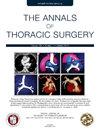Outcomes of Surgical Interrupted Aortic Arch Repair in 181 Patients With Biventricular Circulation
IF 3.6
2区 医学
Q1 CARDIAC & CARDIOVASCULAR SYSTEMS
引用次数: 0
Abstract
Background
This study compared the outcomes of primary and staged surgery for interrupted aortic arch (IAA) with biventricular circulation.
Methods
A search of our surgical database identified 181 patients with biventricular anatomy who underwent surgical repair of IAA between 1982 and 2022. The patients were divided according to whether they underwent surgery in 1982 to 2001 or 2002 to 2022 and were categorized according to their anomalies into a simple group and a complex group. Repair was 1-stage in 130 patients (71.8%) and 2-stage in 51 (28.2%).
Results
There were 6 early deaths (3.3%) and 9 (5.0%) late deaths. The 20-year actuarial survival rate was 91.7%. The 20-year survival rate was 94.7% in the simple group and 82.9% in the complex group (P = .007); the respective rates were 91.7% and 96.8% in 1982 to 2001 (P = .63) and 68.4% and 90.1% in 2002 to 2022 (P = .012). Multivariate analysis identified a complex anomaly and surgery performed in 1982 to 2001 to be risk factors for mortality. Aortic arch reintervention was required in 26 patients (balloon dilation, n = 15; surgical, n = 11). The 15-year freedom from reintervention rate improved from 67.8% in 1982 to 2001 to 89.8% in 2002 to 2022 (P = .041). Multivariate analysis identified type of surgical approach and emergent surgery to be risk factors for reintervention on the aortic arch.
Conclusions
The results of IAA surgery have improved in recent years, especially for complex cases. Development of surgical techniques and individualized treatment strategies could reduce postoperative mortality and morbidity. However, follow-up for recurrence of aortic arch obstruction is necessary.
181 例双心室循环患者的主动脉弓手术间断修复效果。
背景:本研究比较了双心室循环主动脉弓中断(IAA)的初次手术和分期手术结果:这项研究比较了双心室循环主动脉弓中断(IAA)的初次手术和分期手术的结果:在我们的手术数据库中搜索到了1982年至2022年期间接受过手术修复双心室解剖的IAA的181例患者。根据患者是在1982-2001年还是2002-2022年接受的手术,将其分为简单组和复杂组。130名患者(71.8%)接受了一期修复手术,51名患者(28.2%)接受了二期修复手术:结果:共有6例早期死亡(3.3%)和9例晚期死亡(5.0%)。20年精算生存率为91.7%。简单组的20年存活率为94.7%,复杂组为82.9%(P=.007);1982-2001年的存活率分别为91.7%和96.8%(P=.63),2002-2022年的存活率分别为68.4%和90.1%(P=.012)。多变量分析发现,复杂畸形和1982-2001年进行的手术是导致死亡的风险因素。26名患者需要进行主动脉弓再介入治疗(球囊扩张,15人;手术,11人)。15年免再介入率从1982-2001年的67.8%提高到2002-2022年的89.8%(P=0.041)。多变量分析发现,手术方式和急诊手术是主动脉弓再介入的风险因素:近年来,IAA手术的效果有所改善,尤其是复杂病例。手术技术和个体化治疗策略的发展可降低术后死亡率和发病率。然而,主动脉弓阻塞复发的随访是必要的。
本文章由计算机程序翻译,如有差异,请以英文原文为准。
求助全文
约1分钟内获得全文
求助全文
来源期刊

Annals of Thoracic Surgery
医学-呼吸系统
CiteScore
6.40
自引率
13.00%
发文量
1235
审稿时长
42 days
期刊介绍:
The mission of The Annals of Thoracic Surgery is to promote scholarship in cardiothoracic surgery patient care, clinical practice, research, education, and policy. As the official journal of two of the largest American associations in its specialty, this leading monthly enjoys outstanding editorial leadership and maintains rigorous selection standards.
The Annals of Thoracic Surgery features:
• Full-length original articles on clinical advances, current surgical methods, and controversial topics and techniques
• New Technology articles
• Case reports
• "How-to-do-it" features
• Reviews of current literature
• Supplements on symposia
• Commentary pieces and correspondence
• CME
• Online-only case reports, "how-to-do-its", and images in cardiothoracic surgery.
An authoritative, clinically oriented, comprehensive resource, The Annals of Thoracic Surgery is committed to providing a place for all thoracic surgeons to relate experiences which will help improve patient care.
 求助内容:
求助内容: 应助结果提醒方式:
应助结果提醒方式:


